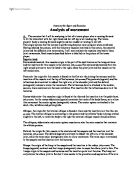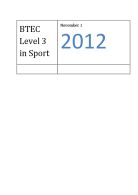Oblique- the origin for the internal oblique is found at ilium and the insertion is at the ribs. (AS pe notes) The internal oblique is contracting in the picture and the athletes’ body is being rotated slightly to the left, to rotate the body to the right the external oblique muscle would contract.
The obliques, abdominals and erector spinae muscles are also the main muscles that maintain the athletes posture.
Deltoid- the origin for this muscle is the clavicle and the scapula and the insertion is at the humerus. (AS pe notes) The deltoid (agonist) contracts to abduct the left arm, at the shoulder joint, while the teres major (antagonist) relax to allow movement. The teres major is attached to the scapula and the insertion is at the humerus.
Biceps- the origin of the bicep is the scapula and the insertion is the radius. (AS pe notes) The biceps (agonist) contract and the triceps (antagonist) relax to cause the elbow joint to flex. The triceps origin is the scapula and humerus and the insertion point is at the ulna. The bicep not only allows the elbow joint to flex but it also assists in the pronation and supination of the arm. As the biceps relax the pronator teres contracts, which brings the radius over the ulna, to turn the left hand palm down. This is known as pronation. Also if the bicep contracts the pronator teres relaxes and the right hand palm turns up, this is known as supination. The origin of the pronator teres is the ulna and humerus and the insertion is as the radius.
Palmaris longus and flexor carpi radialis- these two muscles contract to flex the right hand wrist. The origin for both muscles is the humerus and the insertions are the metacarpals.
Inferior body
Gluteus maximus- the origin of this muscle is found at the ilium and sacrum and the insertion is at the femur. (AS pe notes) In this picture the gluteus maximus and hamstring are contracted to extend the hip of the right leg and in the left leg the gluteus maximus is relaxed, to allow the leg to abduct.
Hamstrings- the origins of these muscles are found at the pelvis and pubis and the insertion are at the tibia and fibula. (AS pe notes) The hamstring is contracted in the right leg, which is flexing the knee joint. This makes the hamstrings the agonist and the quadriceps the antagonist, in the right leg. However the left leg is extended so the quadriceps are contracted and the hamstring are relaxed. Now the hamstrings are the antagonists and the quadriceps are the agonists. The origins for the quadriceps are the ilium and pubis and the insertions are found at the fibula, tibia, patella and femur.
Sartorius- the origin for this muscle is found at the ilium and the insertion is found at the tibia. (AS pe notes) The Sartorius is the longest muscle in the body and along with the quadriceps contracts to flex hip and extend knee joint.
Tibialis anterior and Extensor digitorum longus - the origin for the Tibialis anterior muscle is the tibia and the Extensor digitorum longus is attached to the fibula, these are then both attached to the metatarsals. (AS pe notes) These two muscles contract to allow dorsi flexion of the left foot.
Gastrocnemius- the origin for this muscle is the femur and the insertion point is the calcaneus. (AS pe notes) This muscle is part of the action of dorsal flexion as it is the antagonist and the tibialis anterior and extensor digitorum longus are the agonists. The gastrocnemius also assists in flexion of the knee.
B.
There are three types of muscle contraction seen in sport. The first two involve the movement of a joint by increasing the tension on the joint muscle, these sorts of contractions are known as Isotonic. The first of these two types of contractions is called concentric. This form of muscle contraction occurs when the muscle shortens under tension, this is probably the most common voluntary muscle contraction. An example of this can be seen in picture 1 the person is lifting the weight and their bicep is being shortened under tension. The second of the two isotonic contractions is when the muscle is lengthened under tension so the person lifting the weight would start to lower it their bicep would be under tension but becoming longer, trying to lower the weight.
1. 2.
The third type of muscle contraction seen in sport is called Isometric. This form of contraction involves no joint movement as the muscle stays the same length under tension. A good example of this can be seen in diagram two, where the athlete is holding a weight above their heads. The weightlifters arm muscles would be under a lot of tension but the whole muscle would not be changing length or shape. In the stage of this exercise where the athlete was lifting the weight from the floor the contraction type would have changed from concentric to eccentric.
The nervous system plays a huge roll in our bodies, without it our heart would not pump, lungs not expand and deflate to allow us to breath and our muscle would not move. Every skeletal muscle is controlled by a nerve impulse, which comes via the nervous system. The main nervous system in the body is known as the central nervous system or CNS, which includes the brain and spinal cord. This is the part of the nervous system that sends messages from the brain to the muscles. The part of the nervous system that sends messages from the muscles to the brain is known as the peripheral nervous system.
In order to make a muscle contract a nerve impulse from the CNS is sent to a neurone or nerve cells, which either goes straight from the CNS to the muscle fibre or the neurons group together to carry the information to the muscle fibre. These groups of neurons are known as motor units and they are much more efficient at reaching the larger muscle groups to deliver the nerve impulse, to contract the muscle. When the nerve impulse reaches the muscle fibre it will send an electrical wave, which would contract the muscle fibre.
As skeletal muscles are found in pairs during the contraction of one muscle the other cannot be stimulated. In order for our muscles to contract we must first have a supply of energy going to them and our nervous system assists in this. During exercise the muscle also need a larger supply of blood than they would at rest. So the nervous system also controls this by stimulating many of the vessels supplying blood to organs such as the stomach and narrows them to decrease blood flow.
Reference:







